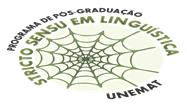Banca de QUALIFICAÇÃO: EDNÉIA BENTO DE SOUZA FERNANDES
Uma banca de QUALIFICAÇÃO de DOUTORADO foi cadastrada pelo programa.DISCENTE : EDNÉIA BENTO DE SOUZA FERNANDES
DATA : 26/06/2025
HORA: 14:00
LOCAL: Videoconferência
TÍTULO:
Naming to belong: the construction of toponyms in Brazilian Sign Language by Deaf Students on the Brazil-Bolivia border
PALAVRAS-CHAVES:
Toponymy; Libras; Sign languages; Autoethnography; Borderland.
PÁGINAS: 97
GRANDE ÁREA: Lingüística, Letras e Artes
ÁREA: Lingüística
SUBÁREA: Lingüística Aplicada
RESUMO:
This research is part of the research line Studies of Language Processes and Social Practices, within the Graduate Program in Linguistics at the State University of Mato Grosso (UNEMAT). Its main objective is to produce a cartography of borderland affects of deaf individuals living on the Brazil-Bolivia border, through an autoethnographic approach that evokes and documents toponymic signs referring to the neighborhoods of Guajará-Mirim (RO), a city bordering Guayaramerín, Bolivia. By means of this autoethnography and the recording of toponymic signs in Brazilian Sign Language (Libras), the study seeks to analyze the importance of lexicon in the linguistic, cultural, and educational development of deaf people in border contexts, and to understand how the border space influences the relationship between being deaf and being an educator. From a transdisciplinary perspective, the research also aims to identify intersections between Onomastics and Historical-Cultural Theory, in order to validate the importance of naming practices and sign language documentation as tools for social transformation and as compensatory elements in the human development of deaf individuals. The study culminates in the development of a didactic booklet, designed to disseminate these lexical resources within schools, the academic community, and among the families of deaf people. The methodology is grounded in Post-Critical Studies, dialoguing with Cultural Studies, and employs autoethnography as the primary method of data production, collection, and analysis. The concept of the border is experienced and re-experienced through the researcher's evocations and lived experiences, in articulation with bibliographic and documentary research. The findings are presented in two sections. The first explores the spatial and temporal constitution of the city of Guajará-Mirim through theoretical contributions from Geography, Onomastics, and Historical-Cultural Psychology. Results indicate that deaf individuals are expressions of human variability, and that the challenges faced by deaf children stem from socially constructed inequalities that hinder their humanization and create cultural barriers to accessing language and culture. In this context, Onomastics emerges as a powerful alternative for lexical registration and for the teaching of both Libras and Portuguese. The research concludes with the presentation of visual representations of name-signs for Guajará-Mirim's neighborhoods, compiled into a bilingual (Libras/Portuguese) didactic booklet. This is proposed as a pedagogical tool for strengthening borderland cultural identity and supporting the linguistic development of deaf children in local public schools.
MEMBROS DA BANCA:
Presidente - 466.104.133-04 - ALEXANDRE MELO DE SOUSA - UFAC
Interno - 638.809.461-91 - RUBERVAL FRANCO MACIEL - UNEMAT
Externo à Instituição - ANDRÉ NOGUEIRA XAVIER - UFPR



